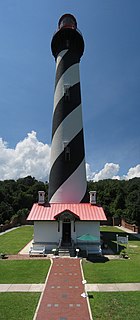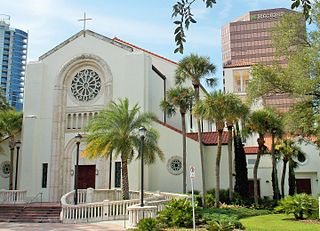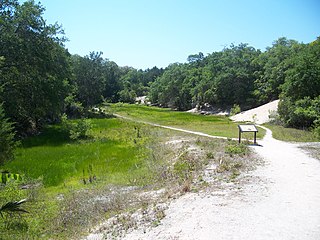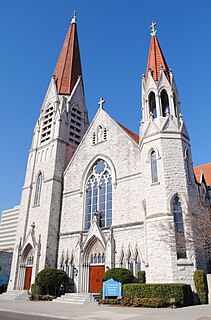
Coquina is a sedimentary rock that is composed either wholly or almost entirely of the transported, abraded, and mechanically-sorted fragments of the shells of molluscs, trilobites, brachiopods, or other invertebrates. The term coquina comes from the Spanish word for "cockle" and "shellfish".

Ste. Anne de Détroit (Sainte-Anne-de-Détroit) was founded July 26, 1701 by French colonists in New France, and is the second-oldest continuously operating Roman Catholic parish in the United States. The current Gothic Revival cathedral-styled church, built in 1886, is located at 1000 Ste. Anne Street in Detroit, Michigan, in the Richard-Hubbard neighborhood, near the Ambassador Bridge, and the Michigan Central Station. At one time it was the seat of a diocese that included French territory in Ontario, Canada south of the Detroit River.

The Basilica-Cathedral of St. John the Baptist in St. John's, Newfoundland and Labrador is the metropolitan cathedral of the Roman Catholic Archdiocese of St. John's, Newfoundland and the mother church and symbol of Roman Catholicism in Newfoundland.

Anastasia Island is a barrier island located off the northeast Atlantic coast of Florida in the United States. It sits east of St. Augustine, running north-south in a slightly southeastern direction to Matanzas Inlet. The island is about 14 miles (23 km) long and an average of 1 mile in width. It is separated from the mainland by the Matanzas River, part of the Intracoastal waterway. Matanzas Bay, the body of water between the island and downtown St. Augustine, opens into St. Augustine Inlet.

The Roman Catholic Diocese of St. Augustine is a diocese of the Catholic Church's Latin Church in the U.S. state of Florida. Part of the Ecclesiastical Province of Miami, it covers much of North Florida, including the cities of St. Augustine, Jacksonville, and Gainesville. The bishop's seat is the Cathedral Basilica of St. Augustine; the current bishop is Felipe de Jesús Estévez.

St. James Cathedral is a parish church and the seat of the Bishop of the Catholic Diocese of Orlando, John Noonan. The cathedral's patron saint is James, son of Zebedee, one of the Twelve Apostles of Jesus, and traditionally considered the first apostle to be martyred. The scallop shell has long been the symbol associated with St. James, and the cathedral uses it as its primary symbol. The parish operates St. James Cathedral School on nearby Robinson Street which offers classes from pre-school through eighth grade.

The González–Alvarez House, also known as The Oldest House, is a historic house museum at 14 St. Francis Street in St. Augustine, Florida. With a construction history dating to about 1723, it is believed to be the oldest surviving house in St. Augustine. It is also an important example of the St. Augustine's Spanish colonial architectural style, with later modifications by English owners. It was designated a U.S. National Historic Landmark in 1970. The house is now owned by the St. Augustine Historical Society and is open for public tours as part of the Oldest House Museum Complex. Evidence can be seen of the Spanish, British, and American occupations of St. Augustine.

The Spanish Coquina Quarries are an historic site in St. Augustine Beach, Florida. They are located off A1A in Anastasia State Park. On February 23, 1972, they were added to the U.S. National Register of Historic Places.

The Basilica of the Immaculate Conception is a historic Catholic church in Downtown Jacksonville, Florida, U.S. A parish church in the Diocese of St. Augustine, it represents Jacksonville's oldest Catholic congregation. The current building, dating to 1910, was added to the U.S. National Register of Historic Places in 1992 as the Church of the Immaculate Conception, and was named a minor basilica in 2013. It is located at 121 East Duval Street; its current pastor is Very Reverend Blair Gaynes.

The Cathedral of the Sacred Heart, is the seat of the Bishop of the Roman Catholic Diocese of Pensacola-Tallahassee. It shares this distinction with the Co-Cathedral of Saint Thomas More in Tallahassee. The cathedral is named in honor of the Sacred Heart of Jesus, and is located in Pensacola, Florida.

St. Augustine Catholic Church, also called Olde St. Augustine's, is a historic Catholic church in Philadelphia, Pennsylvania, United States. Consecrated in 1848, the Palladian-style church was designed by Napoleon LeBrun. It is listed on the National Register of Historic Places.

Nombre de Dios is a Spanish Catholic mission in St. Augustine, Florida, United States, on the west side of Matanzas Bay. It is part of the Roman Catholic Diocese of St. Augustine.

St. Francis Barracks is a historic structure constructed of coquina stone located on Marine Street in St. Augustine, Florida, named in honor of St. Francis of Assisi. The barracks were constructed between 1724 and 1755 by friars of the Order of St. Francis, to replace a series of wooden buildings which had been destroyed by the ravages of the tropical climate in La Florida and by fire, both accidental fires and occasional intentional ones, such as when the city was razed by the English in 1702.

The Memorial Presbyterian Church is a historic church located at 32 Sevilla Street in St. Augustine, Florida, United States. The church has been named by many news outlets, including CNN and USA Today, as one of the religious wonders of the U.S. and one of the most beautiful Protestant churches in the world. The church was built in 1889 by business tycoon and St. Augustine benefactor Henry Morrison Flagler and dedicated in honor of his daughter Jennie Louise Benedict, who died following complications from childbirth at sea the same year, hence the word Memorial.

Tolomato Cemetery is a Catholic cemetery located on Cordova Street in St. Augustine, Florida. The cemetery was the former site of "Tolomato", a village of Guale Indian converts to Christianity and the Franciscan friars who ministered to them. The site of the village and Franciscan mission is noted on a 1737 map of St. Augustine. A cemetery for the inhabitants of the village was also located on the grounds, with a portion of this cemetery set aside for former American black slaves, who had converted to Catholicism after escaping bondage in the Carolinas.

St. Ann's Cathedral is a Catholic cathedral in Great Falls, Montana, United States. Along with St. Patrick's Co-Cathedral in Billings, Montana it is the seat of the Diocese of Great Falls-Billings. In 1991 it was included as a contributing property in the Great Falls Northside Residential Historic District on the National Register of Historic Places.

The Basilica of St. Fidelis, commonly known as the Cathedral of the Plains, is a Romanesque-style Roman Catholic parish church in Victoria, Kansas, United States. It was raised to the status of a Minor Basilica in 2014 and is also known as The Basilica of the Plains.

The Basilica Shrine of St. Mary is a Minor Basilica in the Catholic Church located in Wilmington, North Carolina, in the Diocese of Raleigh. It was included as a contributing property in the Wilmington Historic District on the National Register of Historic Places in 1974.

St Peter and Paul's Old Cathedral is a heritage-listed former cathedral and now parish church at 42 Verner Street, Goulburn, Goulburn Mulwaree Council, New South Wales, Australia. It was designed by Andrea Stombuco and Charles Spadacini and built from 1871 to 1890 by C. J. O'Brien and Wilkie Bros. It is also known as St. Peter and Paul's Former Cathedral and St Peter and Paul's Catholic Cathedral; Saints Peter and Paul's Catholic Cathedral. It was added to the New South Wales State Heritage Register on 20 April 2009.













































